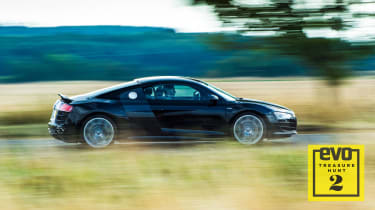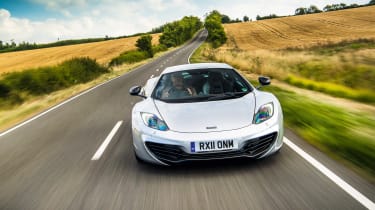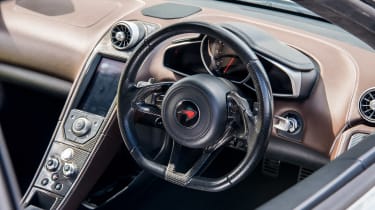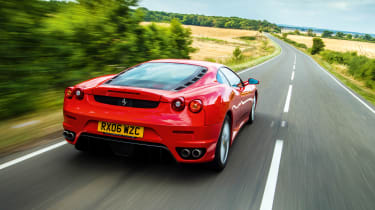Cheap supercars: mid-engined exotics on a budget
A cheap supercar may seem somewhat of an oxymoron, but dwindling values mean that some of evo’s mid-engined heroes have moved into the realm of ‘dare to dream’
For as long as there are internal-combustion-engined cars, debate will rage over where is the most advantageous place to put the engine. But park the prejudices and examine the physics and, for people like us at least, you’re left with only one logical conclusion – mid-engined is best. With all the masses bundled into the centre of the car you’re far more likely to achieve the perfect 50:50 weight distribution, plus (here comes the sciencey stuff) the lower polar moment of inertia delivers quicker responses. And then there’s the motorsport connection. Ever since Cooper revolutionised Formula 1 in the 1950s, the fastest racers have all had their engines behind the driver. Hell, when outright pace is the goal, even Porsche has abandoned its rear-engined dogma – its quickest 911 racer, the RSR, is a middy.
The desirability of the mid-engined format means that you can get these machines in all shapes and sizes, and at all sorts of budgets. But if you’re going to do it, you might as well do it properly – and that means going large with a genuine supercar. These are the models where the layout makes most sense, as it places the bulk of a big powerplant centrally rather than leaving it hanging out at either end and upsetting the balance. It’s also the sector with the richest mid-engined heritage, with a lineage that can be traced all the way back to the Lamborghini Miura. We won’t pretend this is the cheapest way into mid-engined motoring, but neither is it as ruinously expensive as you might think. Crucially, these machines are tougher than you’d ever imagine, free of many of the highly strung frailties that traditionally forced this type of car into the role of pampered garage queen rather than serious driving tool.
To prove our theory, we’ve gathered together a trio of second-hand examples – one from a maker better known for its mainstream saloons, one from a relative newcomer to road cars (albeit with a stellar motorsport CV) and one from a marque with an impeccable and lengthy mid-engined pedigree.
Today, more than a decade after its debut, the original Audi R8 looks catwalk good. Even when parked alongside the McLaren MP4-12C and Ferrari F430, we all agree it’s the tautly-styled German car that gets the nod for kerb appeal. It’s a cliché, yes, but the beautifully proportioned Audi really does look like it has been milled from a solid block of aluminium (it is constructed almost entirely of the stuff, after all). Of course, you could go for the V8 (and with prices starting at little more than £30,000 the temptation is huge), but when there’s also a 518bhp V10 on offer it’d be rude not to, especially when it looks as good as Martin Spain’s Phantom Black Metallic example. Prices start at around £50k (Martin’s mint 24,000-mile 2009 car is currently up for £51,250, if you’re interested), which looks a lot but is actually less than the price of a new TT RS. Just think about that for a moment…

Like the exterior, the inside of the Audi is beautifully crafted, and while it feels a little too closely related to the brand’s sedate saloons, you get the impression it’ll still look and feel fresh in 100,000 miles’ time. Same goes for the mechanicals. For starters, the V10 is robust, the only caveat being that any potential purchase should have been serviced annually (Audi ran a ‘long-life’ two-year-interval option), while clutches on manual cars can expire after as little as 20,000 miles. And if you must have an auto, then steer clear of the clunky R-tronic single-clutch automated manual and seek out a later (2012-onwards) S-tronic twin-clutch. It’s also worth noting that a lack of aftermarket specialists means you’ll pay Audi prices for consumables such as brake discs, which are around £300 each. Suspension components can also get baggy on higher-mileage cars, and the Magnetic Ride dampers cost around £800 a corner to replace if they go haywire.
There are no such problems with Martin’s car, which feels as fresh as the day it was hand-assembled at Audi’s Neckarsulm plant. It’s a sign of how quickly the sector has developed that the R8 is a surprisingly analogue supercar. From the lovely exposed gate for the manual gearshift to the lack of driver modes – you can select from two damping settings and two ESP options, but that’s it – the Audi is a car that puts the emphasis on the driver.
Audi R8 V10
| Engine | V10, 5204cc |
| Power | 518bhp @ 8000rpm |
| Torque | 391lb ft @ 6500rpm |
| Weight | 1620kg (325bhp/ton) |
| 0-62mph | 4.1sec |
| Top speed | 194mph |
| Price today | £49,000-80,000 |
| On sale | 2009-2015 |
Of course, it’s the engine and transmission that form the core of the Audi’s appeal, getting your heart pumping faster the moment you twist the key in the ignition. Based on the same unit as in the Lamborghini Gallardo, it plays the full internal-combustion orchestra, from gravelly growl low down to full-on, multi-layered war cry at the red line. The other noise that gets you grinning is the ‘click-clack’ backbeat to gearchanges, with each shift giving you the chance to fully exploit the explosive energy of that torque-rich, naturally aspirated motor, which pulls from idle all the way to 8000rpm with the elastic, linear urge of an electric motor.
So good is the drivetrain that it’s easy to overlook the Audi’s chassis. There’s some genuine feedback through the meatily So good is the drivetrain that it’s easy to overlook the Audi’s chassis. There’s some genuine feedback through the meatily weighted hydraulic steering, while the grip, body control and quattro four-wheel-drive traction are deeply impressive, allowing you to pick apart flowing roads with minimal effort. If anything, the Audi is a little too good. So high are its limits that you really have to push hard to wake up the chassis, at which point you’re travelling very quickly indeed. This polished approach is also a mixed blessing when you’re taking it steady, because so slick, refined and easy to use is the R8 that sometimes you forget you’re behind the wheel of something so special.
There are no such problems with the McLaren MP4-12C, which grabs you by the lapels and shakes you vigorously every time you drive it. We’ve moved up a bit in price now, with at least £85,000 needed to get the Macca’s smooth, pebble-shaped key fob in your hand, but the extra outlay is amply repaid in both performance and drama. McLaren is a pillar of the supercar firmament these days, so it’s shocking to recall that it was only seven years ago that the MP4‑12C (later renamed simply 12C) represented the brand’s first foray into road cars since the hallowed F1.
Despite a design that’s only a few years newer than the R8, the McLaren’s approach couldn’t be more different, its hi-tech, highly configurable pursuit of high performance marking it out as a progenitor of today’s breed of bleeding-edge supercars. It’s not a classically handsome car, the 12C, but it demands your attention, particularly in the shimmering silver of this example, which is actually McLaren’s own – the first one off the line, in fact. Under the skin is the now ubiquitous MonoCell carbonfibre monocoque, hanging from which is the trick double-wishbone suspension that couples coil springs with hydraulically interconnected dampers that allow the McLaren to do away with traditional anti-roll bars. And there’s no limited-slip differential: instead it gets a Brake Steer set-up that brakes individual inside rear wheels for better turn-in.
Power comes from the twin-turbocharged 3.8-litre V8 M838T, which was developed in collaboration with British engineering firm Ricardo. Like the MonoCell, this unit has been a constant throughout the McLaren line-up, albeit in increasingly modified forms. In the early cars it developed 592bhp and 442lb ft of torque, while from 2012 onwards power was raised to 616bhp, with torque unchanged. Regardless of output, you get the same ‘seamless shift’ seven-speed twin-clutch gearbox. There are also separate Normal, Sport and Track settings for the chassis and drivetrain, allowing you to pick and mix your favourite combination.
McLaren MP4-12C
| Engine | V8, 3799cc, twin-turbo |
| Power | 592bhp @ 7000rpm |
| Torque | 442lb ft @ 3000-7000rpm |
| Weight | 1434kg (419bhp/ton) |
| 0-62mph | 3.3sec |
| Top speed | 205mph |
| Price today | £85,000-110,000 |
| On sale | 2011-2014 |
Given the incredible complexity of the McLaren, it’ll come as a bit of a surprise to find that it’s actually relatively hassle-free to own. Early cars suffered niggles, but reliability quickly improved. Electrical glitches are the most common issue, with the biggest bugbear being the IRIS infotainment system, which is prone to hissy-fits that even numerous software updates can’t cure. Still, we’d recommend a McLaren warranty, which when combined with an annual service will see you shell out around £4500 a year. Not cheap, but then nobody ever said supercars were the value option.
Lift open the dihedral driver’s door (not as easy as you’d think given this early car’s frustratingly erratic swipe-sensitive handle; later 2012 cars got a proper button) and you’ll instantly forget the expense. Like all McLarens, you sit well forward in a straight-legged recumbent driving position that’s enhanced by the gloriously panoramic view over the low dashboard. Thumb the starter and the V8 erupts into life before settling to a bassy idle. It sounds agricultural in this company, but there’s still something addictive about its hard-edged blare under full throttle and the sigh and chatter of the turbos as you come off the gas. By gum it’s quick, too. There’s noticeable lag low down, but once the compressors are pumping properly at 3000rpm, the 12C explodes down the road, rifling through its ratios with jaw-dropping speed and smoothness.
Compared with the Audi’s and Ferrari’s, the McLaren’s steering feels freakishly quick, the MP4 responding instantly to the smallest input. Other-worldly front-end grip and a virtually no-roll cornering stance allow you to slice through corners at speeds the other two simply couldn’t countenance. It’s just soooo fast across the ground, its clever suspension filtering out bumps and keeping the chassis level. Brake hard and your rear view is obliterated by the air brake rising to help slow the car. Very cool. Yet there’s real old-fashioned feedback here; you can feel the forces building through the seat of your pants, while the wheel constantly writhes in your hands. In truth, the car’s limits are almost too high for the road, and you soon realise you’re getting your thrills by trying to carry as much speed as possible, which turns out to be a great deal of speed indeed.
The contrast with the Ferrari couldn’t be greater. The F430 debuted just seven years before the MP4-12C, but drive the two back-to-back and the gap could be decades. Make no mistake, the F430 marked a major technological step for the Prancing Horse, giving drivers the first taste of the manettino and the electronically controlled E-Diff, plus there were adaptive dampers and the option of a semi-automatic transmission, but on the road the F430 feels like a car designed when chassis development relied on analogue feel rather than sophisticated algorithms. It’s way slower than the McLaren, but the rewards it delivers are way greater.
Ferrari F430
| Engine | V8, 4308cc |
| Power | 483bhp @ 8500rpm |
| Torque | 343lb ft @ 5250rpm |
| Weight | 1449kg (339bhp/ton) |
| 0-62mph | 4.0sec |
| Top speed | 196mph+ |
| Price today | £75,000-160,000 |
| On sale | 2004-2010 |
Alex Read’s immaculate Rosso Red coupe looks dainty and delicate alongside our newer pair, but the Pininfarina-penned shape (overseen by American Frank Stephenson, who also had a hand in the McLaren’s design) still draws attention like few others. If anything ages the F430 it’s the cabin, which looks stark and simple compared with the Audi’s and McLaren’s. Thin pillars mean excellent visibility, but the plastics feel a bit low-rent and the LCD screen for the fuel gauge wouldn’t pass muster in a £10 Casio watch. Yet once you’ve settled into that deeply supportive seat, gripped the gorgeous three-spoke wheel and clocked that large, yellow-backed rev counter, you’re ready to forgive the Ferrari anything.
Loosely based on the 360 Modena, the 430 represented a big leap forward for Ferrari. Not only was it endowed with the latest electronic aids, it also marked the debut of the F136 V8 that was developed in partnership with Maserati. Featuring a 4.3-litre capacity, a flat-plane crank and four valves per cylinder (the old 360 had a five-valve head) it develops 483bhp at a heady, heavenly 8500rpm. It really does emit a lovely noise, snarling and howling as you work it harder and harder. No, it’s not nearly as fast as the newer cars here, but the combination of that soundtrack, a healthy dollop of low-down torque, reasonably short gearing and near-instant throttle response means it feels more than quick enough.
A six-speed manual was standard (for the last time on a mid-engined Ferrari) but most got the single-clutch F1 paddleshift, as fitted to this car. Treat it like a modern twin-clutcher and, frankly, it’s hopeless, the ponderous delay between shifts causing nodding-dog syndrome. Learn to give a small lift off the throttle between changes, however, and you can smooth the process nicely – it’s no faster, but it adds a layer of interaction that other autos can’t match.
Begin to explore its chassis and the Ferrari feels more blunt than the other two – it responds languidly to steering inputs and the supple ride makes you think it’ll be soft and imprecise. Yet pick up the pace, twist the manettino to Sport or Race to wake up the E-Diff and slacken off the traction control, and the F430 turns sublime. The lower-geared steering is beautifully precise and brimming with feedback, while the fact grip levels ultimately aren’t high allows you to revel in the chassis’ exquisite balance for more of the time – a task that’s made more satisfying by the trick diff, which makes the transition to power oversteer so natural that you’re able to pick and choose at will how you exit a corner. It’s so engaging and so adjustable that you’ll never tire of flinging it down your favourite roads.
You may now be expecting the caveat that this is an old Ferrari so it’ll constantly go wrong and cost a fortune to fix. Servicing certainly isn’t cheap, but neither is the F430 a diva when it comes to maintenance. Most specialists describe the V8 as ‘bulletproof’ (it features chain- rather than belt-driven cams), with the most likely failing being a cracked exhaust manifold, which can be welded rather than replaced. The gearboxes are tough as well, although the clutch on the F1 transmission can expire after just 12,000 miles if it does a lot of town work. Other than that it’s just clonking suspension bushes and ball joints you have to keep an ear out for. Even the cost of buying the car isn’t outrageous (for a decade or so old Italian supercar, that is). Ignore the Scuderia models, which are now well north of £200k, and around £85,000 should buy you a corker.
So there you have it, three mid-engined exotics that are as sensational to drive as they are (relatively) sensible to own. Which would I have? Well, the Audi and McLaren are both gobsmackingly brilliant, but it’s the bewitching Ferrari that has me under its spell.






